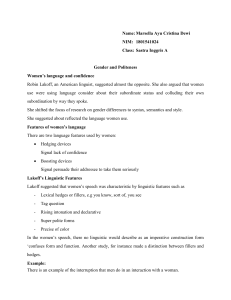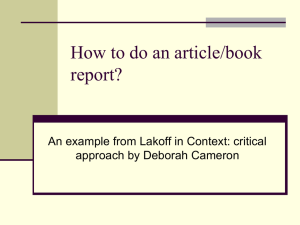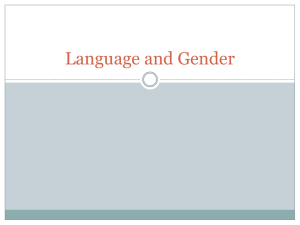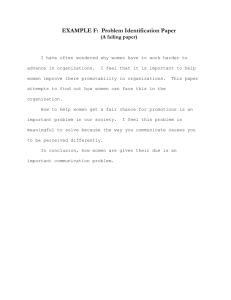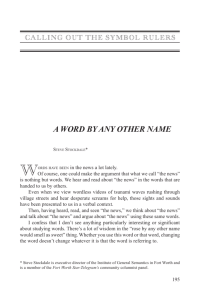Assignment 7-Topics in Applied Linguistics
advertisement
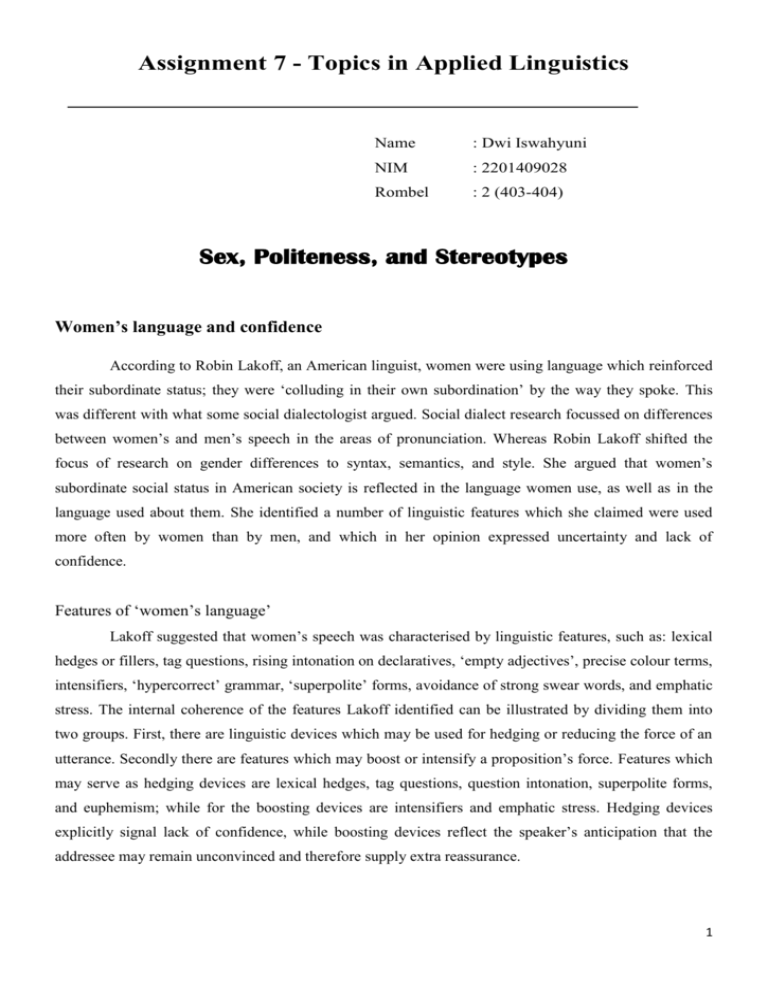
Assignment 7 - Topics in Applied Linguistics Name : Dwi Iswahyuni NIM : 2201409028 Rombel : 2 (403-404) Sex, Politeness, and Stereotypes Women’s language and confidence According to Robin Lakoff, an American linguist, women were using language which reinforced their subordinate status; they were ‘colluding in their own subordination’ by the way they spoke. This was different with what some social dialectologist argued. Social dialect research focussed on differences between women’s and men’s speech in the areas of pronunciation. Whereas Robin Lakoff shifted the focus of research on gender differences to syntax, semantics, and style. She argued that women’s subordinate social status in American society is reflected in the language women use, as well as in the language used about them. She identified a number of linguistic features which she claimed were used more often by women than by men, and which in her opinion expressed uncertainty and lack of confidence. Features of ‘women’s language’ Lakoff suggested that women’s speech was characterised by linguistic features, such as: lexical hedges or fillers, tag questions, rising intonation on declaratives, ‘empty adjectives’, precise colour terms, intensifiers, ‘hypercorrect’ grammar, ‘superpolite’ forms, avoidance of strong swear words, and emphatic stress. The internal coherence of the features Lakoff identified can be illustrated by dividing them into two groups. First, there are linguistic devices which may be used for hedging or reducing the force of an utterance. Secondly there are features which may boost or intensify a proposition’s force. Features which may serve as hedging devices are lexical hedges, tag questions, question intonation, superpolite forms, and euphemism; while for the boosting devices are intensifiers and emphatic stress. Hedging devices explicitly signal lack of confidence, while boosting devices reflect the speaker’s anticipation that the addressee may remain unconvinced and therefore supply extra reassurance. 1 In some studies women were reported as using more tag questions and boosters than men. However, a more detailed analysis sometimes showed that these forms were not always expressing uncertainty. Lakoff’s linguistic features as politeness devices Tag question could be classified as a boosting device.The tag question is a syntactic device listed by Lakoff which may not only express uncertainty, but also express affective meaning. They may function as facilitative or positive politeness devices, providing an addressee with an easy entree into a conversation. Besides, a tag may also soften a directive or a criticism. Moreover, tag may also be used to as confrontational and coercive devices. Women put more emphasis tahn men on the polite or affective functions of tags, using them as facilitative positive politeness devices. Men, on the other hand used more tags for the expression of uncertainty. Interaction In same-sex interactions, interruptions were pretty evenly distributed between speakers. In crosssex interactions almost all the interuptions were from males. It’s quite clearly gender rather than occupational status, social class, or some other social factor, which most adequately accounts for the interactional patterns described. Gossip Gossip describes the kind of relaxed in group talk that goes on between people in informal contexts. In Western society, gossip is defined as ‘idle talk’ and considered particularly characteristic of women’s interaction. Sexist Language Language conveys attitudes. Sexist attitudes stereotype a person according to gender rather than judging on individual merits. Sexist language encodes stereotyped attitudes to women and men. The study of sexist language is concerned with the way language expresses both negative and positive stereotypes of both women and men. Feminist have claimed that English is a sexist language. Sexism involves behaviour which maintains social inequalities between women and men. English language discriminates against women. In the semantic area the English metaphors available to describe women include an extraordinarily high number of derogatory images compared to those used to describe men. Animal imagery is one example where the images of women seem considerably less positive than those for men. Consider the negativity of bitch, old biddy, and cow, compared to stud and wolf. Animal imagery which refers to men often has at least some positive component (such as wiliness or sexual prowess). 2
